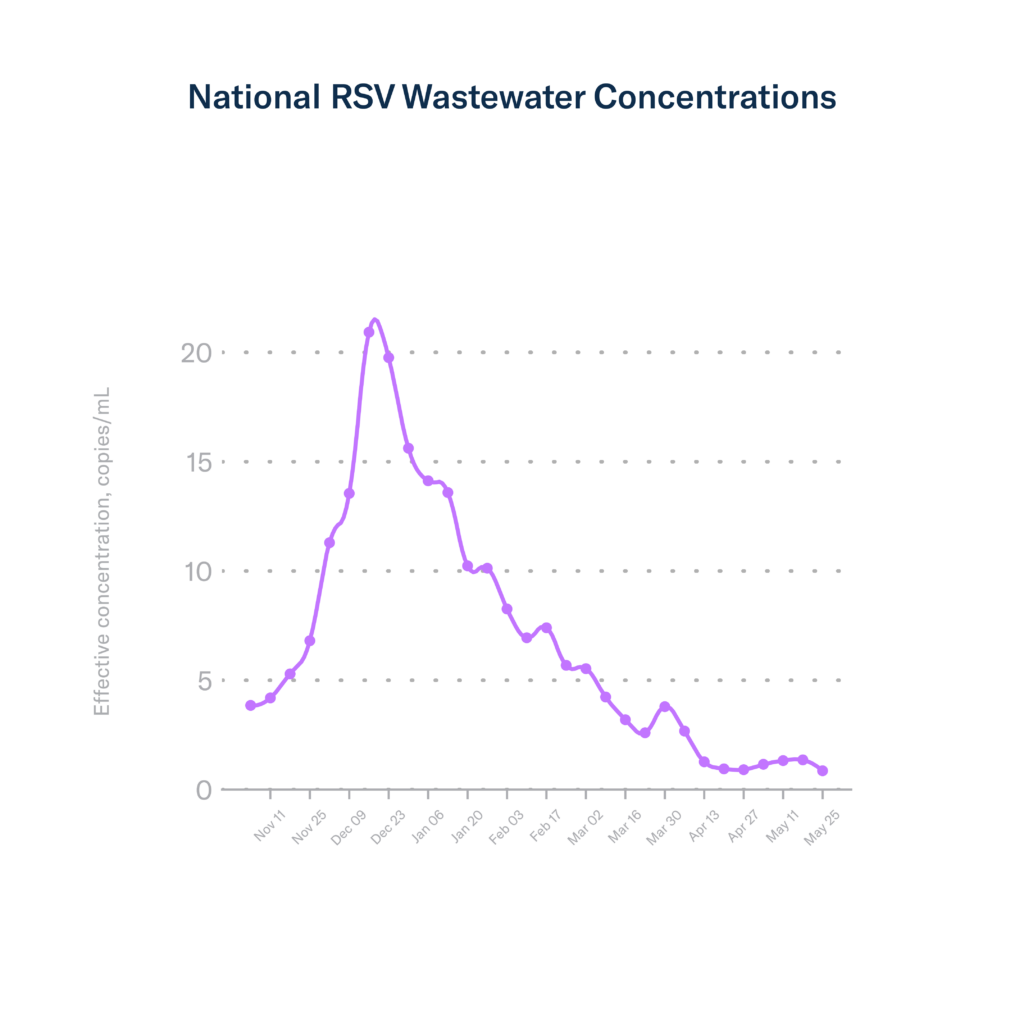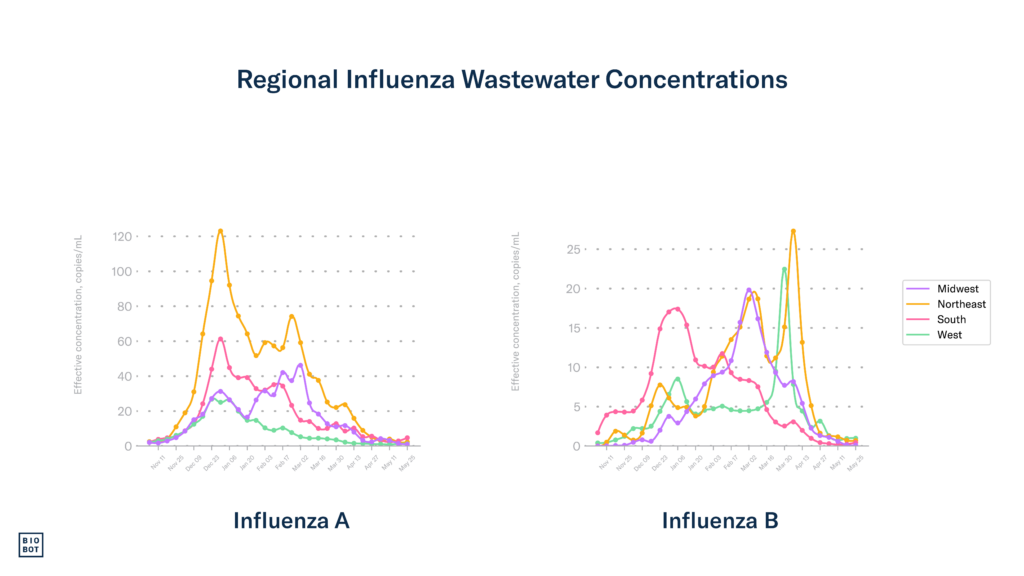At Biobot, we analyze wastewater across the country for various infectious disease pathogens....

Respiratory Virus Risk Reports
Comprehensive Insights for COVID-19, Influenza, and RSV
COVID-19, Influenza, and RSV Wastewater Monitoring in the U.S. | Week of May 27, 2024
Throughout the respiratory season, we analyze wastewater for the presence of respiratory syncytial virus (RSV) and influenza virus (types A and B). Together with COVID-19, these three pathogens are outsized contributors to our seasonal respiratory illness burden. In this data series, we’ll guide you through the wealth of data we’ve gathered from our Biobot Network of national sampling sites, aiming to shed light on emerging trends in respiratory virus activity and community viral load. Our goal is to equip you with information to make informed decisions.

Data Note: Samples are collected from participating locations, and processed by our lab team on a rolling basis. Each point on the figure represents the weekly average concentration, from Sunday – Saturday (corresponding to the MMWR week), aligned to that week’s Saturday.
Contributors

Marisa Donnelly, PhD
Public Health Partnerships Epidemiologist
Previous Risk Reports
Summary: Week of 5/27/24
——
We continue to monitor the rapidly evolving H5N1 influenza virus situation. As we do, a quick reminder that Biobot’s influenza A assay detects the H5N1 influenza subtype, which is an influenza A virus, but does not distinguish between the different subtypes of influenza A (e.g. H5N1 vs H1N1).
Thankfully, we have not seen large, widespread increases in influenza A concentrations. Data through week 21 (May 25th) also indicate that influenza activity remains low in the four US regions. We want to highlight are some important points about the role of Biobot’s wastewater data in understanding the current circulation/risk of H5N1:
- At this point, we cannot determine if these upticks are due to seasonal influenza A virus or if H5N1 could be playing a role in the increase.
- Biobot is currently testing for influenza A in 7 out of the 9 states with positive dairy herds (Texas, New Mexico, Kansas, Idaho, Ohio, North Carolina, and South Dakota), among several other states across the country.
- Our current assays do not distinguish between infections in humans versus infected animals that are shedding into the wastewater system.
This situation is rapidly evolving and our team will continue to closely monitor H5N1. We will provide any additional information as it becomes relevant or available via Twitter and here in the risk reports.
Biobot’s national wastewater network showed stable and very low national concentrations of influenza B and RSV during week 21, while influenza A and SARS-CoV-2 concentrations increased. Nationally, major clinical metrics remain low for COVID-19, influenza, and RSV in week 20. The percentage of outpatient visits due to influenza-like illness (ILI) continues to stay below the national baseline of 2.9%, currently at 2%. Overall, the illness burden due to respiratory viruses remains low.
The Bottom Line: As we head into summer, we are keeping our eyes on two things: 1. Increasing SARS-CoV-2 concentrations which could be signaling the start of a summer wave, and 2. The evolving H5N1 situation, which thankfully does not currently pose a significant threat to human health. Closely monitoring both these situations is essential to protecting human health. Our recommendations to keep yourself and loved ones healthy remain the same: if you feel unwell, minimize contact with others, consider wearing a mask in crowded areas, and stay current with vaccinations and boosters. Taking these precautions can help keep you and your loved ones healthy.
National Outlook
RSV
Nationally, RSV concentrations remained very low in week 21.

Influenza
Nationally, influenza A concentrations slightly increased in week 21 while influenza B concentrations held steady. Overall, both remain low. We are continuing to keep a very close eye on influenza A concentrations as H5N1 is an influenza A virus subtype that our assay picks up.
Clinical data showed that the illness burden due to influenza held steady in week 20. Test positivity from clinical labs did not change in week 20, currently at 2%. The percentage of outpatient visits for influenza-like illness (ILI) – typical in flu, RSV, and COVID-19 patients – also held steady and remains below the national baseline of 2.9%, currently at 2.0%. FluSurv-NET reports that the influenza hospitalization rate per 100,000 persons also remains very low, currently at 0.2 in week 20. These metrics are at levels we would typically expect for this time of year, and indicate low influenza activity.

COVID-19
Wastewater data show that COVID-19 activity and community viral load increased during week 21. The national average SARS-CoV-2 wastewater concentration is now 278 copies per mL.
Clinical metrics continue to show low COVID-19 disease burden in week 20. Test positivity slightly increased, currently at 3.4%. COVID-NET reports that the hospitalization rate per 100,000 persons is 0.8 in week 20. Deaths due to COVID-19 held steady, and currently represent 0.6% of all deaths in the US.

Regional
The South
RSV: In the South, RSV wastewater concentrations declined and remained very low during week 21.
Influenza: In the South, influenza A concentrations slightly increased week 21, but remain low. This regional increase appears to be driving the slight increase in national influenza A concentrations we are observing. Influenza B concentrations, on the other hand, held steady in the South and remained very low. Clinical data continues to confirm that disease burden due to influenza remains low – all Southern states remained in the Minimal ILI activity level through week 20. Mississippi, however, did experience a small increase in outpatient visits due to ILI.
COVID-19: SARS-CoV-2 wastewater concentrations slightly increased in the South during week 21, currently at 173 copies per mL. The two Southern states in COVID-NET, an enhanced hospitalization surveillance system, are Georgia and Tennessee. Georgia experienced a decrease in COVID-19 hospitalization rates in week 20, while Tennessee experienced a very small increase. Hospitalization rates in both states remained low overall.
The Midwest
RSV: RSV concentrations remained stable and very low in the Midwest during week 21.
Influenza: Influenza A & B wastewater concentrations continued to decline in the Midwest in week 21, and remain very low. Clinical data continues to show low influenza illness burden in the Midwest – all states are now in the Minimal ILI activity level. Iowa, however, experienced a small uptick in outpatient visits due to ILI in week 20, going from .9% of visits to 1.5% week 20.
COVID-19: SARS-CoV-2 wastewater concentrations held steady in the Midwest during week 21, currently at 222 copies per mL. Michigan, Minnesota, and Ohio are Midwestern states in COVID-NET. In week 20, Michigan and Ohio experienced decreases in COVID-19 hospitalization rates, while Minnesota experienced a small increase. Hospitalization rates remained low overall in all three states.
The Northeast
RSV: In the Northeast, RSV wastewater concentrations remained very low during week 21.
Influenza: Influenza A & B concentrations held steady and remained very low in the Northeast during week 21. In week 20, all Northeastern states remained in the Minimal ILI activity level, however, Delaware and Vermont experienced slight upticks in outpatient visits due to ILI. Overall, clinical burden due to influenza remains low in the Northeast.
COVID-19: SARS-CoV-2 wastewater concentrations increased in the Northeast during week 21, currently at 377 copies per mL. Connecticut, Maryland, and New York (Northeastern states in COVID-NET) either held steady or experienced decreases in hospitalization rates, which remained low overall in week 20.
The West
RSV: RSV wastewater concentrations remained very low in the West during week 21.
Influenza: Influenza A & B concentrations held steady and remained very low in the West during week 21. Clinical metrics also reflect low influenza activity. During week 20, all Western states remained in the Low or Minimal ILI activity levels and none experienced increases in outpatient visits due ILI.
COVID-19: During week 21, SARS-CoV-2 wastewater concentrations increased in the West, currently at 282 copies per mL. Western states in COVID-NET including California, Colorado, Oregon, and Utah either held steady or experienced decreases in COVID-19 hospitalizations rates in week 20, while New Mexico experienced a slight increase. Hospitalizations in the West remain low overall.



Footnotes:
Wastewater data from Biobot Analytics for RSV, influenza, and SARS-CoV-2 are through May 25, 2024 (MMWR week 21). Clinical data on testing, hospitalizations, and emergency department visits for RSV, influenza, and COVID-19 are from the Centers for Disease Control and Prevention. Updates to clinical data for RSV, influenza, and COVID-19 are through May 18, 2024 (MMWR week 20).






